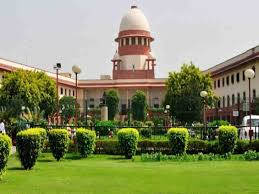Felling of trees in Delhi’s Ridge area: SC holds DDA officials guilty of contempt, criticises ‘administrative overreach’

The Supreme Court of India recently delivered a strong verdict on the unauthorized felling of trees in Delhi’s ecologically sensitive Ridge area. The court found Delhi Development Authority (DDA) officials guilty of contempt of court. It criticized the officials for ‘administrative overreach’ and stressed the need to follow environmental laws and court orders strictly, especially in cities facing serious ecological challenges.
Why the Ridge Area Matters for Delhi
Delhi’s Ridge is often called the city’s “green lung.” It is a large forested area that runs along the Aravalli hills. This green cover acts as an ecological shield. It protects the city from pollution, soil erosion, and extreme weather. The Ridge also supports many species of trees, birds, and animals. It is one of Delhi’s few biodiversity hotspots amid dense urban growth.
The Ridge plays more roles beyond ecology. It serves as a recreational spot for city residents. It helps recharge groundwater, which supports Delhi’s water needs. Due to its importance, the Ridge enjoys protection under environmental laws and court rulings aimed at preventing damage.
Controversy Over Tree Felling in the Ridge
Despite its protected status, reports emerged showing large-scale tree cutting in the Ridge. The DDA allegedly allowed this to clear land for development projects. They did this without getting the required environmental clearances. The DDA also ignored earlier Supreme Court orders that protected the area.
This unauthorized tree cutting sparked anger among environmentalists, locals, and politicians. Many called it a reckless attack on one of Delhi’s vital natural resources. They warned it would worsen pollution and harm wildlife habitats.
Environmental groups filed petitions in the Supreme Court. They asked the court to stop the destruction and punish those responsible.
Supreme Court’s Verdict: Accountability for DDA Officials
The Supreme Court responded firmly. The bench reprimanded DDA officials for violating previous court orders that banned unauthorized tree cutting. The court held the officials in contempt. It called their actions a clear disregard for the law and the environment.
The court condemned the ‘administrative overreach’ by the DDA. It stated that no government body has the right to harm the environment or ignore laws. The court stressed the importance of following legal procedures and respecting environmental protections in development work.
The verdict sends a strong message. It says environmental protection cannot be sacrificed for urban growth. Authorities must balance infrastructure needs with sustainability.
Legal and Environmental Implications
This ruling has major legal and environmental effects. First, the contempt order shows that courts will enforce environmental laws strictly in fast-growing cities. Government agencies will face consequences if they break the law or ignore court orders.
Second, the judgment highlights the Ridge’s importance as a protected ecological zone. The court’s focus on preserving green cover supports India’s constitutional duty to protect the environment under Article 48A. It also reinforces the right to a healthy environment as part of the fundamental right to life.
Environmentally, saving the Ridge is key to fighting Delhi’s pollution and urban heat. Trees in the Ridge filter harmful pollutants, control temperatures, and preserve wildlife. Losing this green cover could harm the health and quality of life of millions.
Reactions from Environmentalists and Citizens
Environmentalists welcomed the court’s decision. They called it a landmark win in the fight to save Delhi’s shrinking green spaces. Many praised the court for acting against bureaucratic negligence and misuse of power that harms the environment.
Local residents expressed relief. They hoped the ruling would protect and restore the Ridge. For them, the area is both an ecological treasure and a place to relax away from city stress.
The verdict spread widely on social media. Citizens urged the government to act quickly to fix the damage and prevent future violations.
What Comes Next: Restoration and Compliance
After the Supreme Court’s ruling, the DDA and other agencies must act fast. They need to stop all tree cutting and start restoring the damaged areas. This may include planting new trees and protecting remaining green zones. Any future projects will have to follow strict environmental clearances.
The ruling will likely push the government to review urban development policies. Authorities must ensure they obey environmental laws and court orders. This will help avoid similar contempt cases later.
The case also shows the need for transparency. More public involvement in decisions affecting natural resources can help balance development with conservation.
Broader Impact: Setting a Model for Urban Environmental Governance
The Supreme Court’s strong action sets an example for other Indian cities facing similar issues. Rapid urbanization is a nationwide trend, making green space protection critical.
This verdict highlights the judiciary’s role in defending environmental rights. It holds public officials accountable for their actions. The ruling reminds all stakeholders that sustainable development is a shared responsibility. Government bodies, courts, civil society, and citizens must work together.
By protecting areas like the Ridge, India can build healthier cities. These cities will support growth without sacrificing nature or public health.






